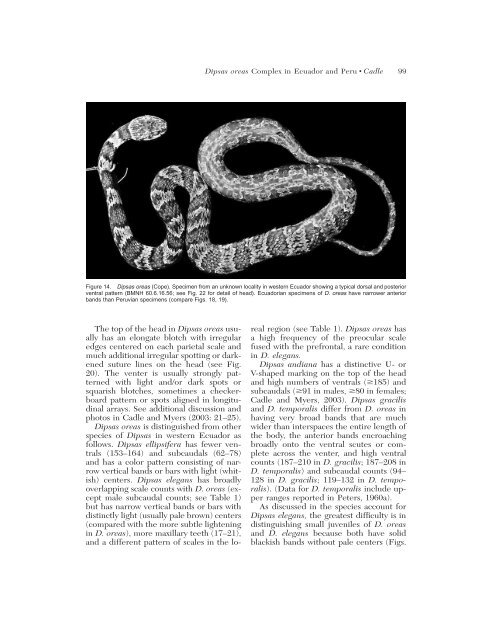systematics of snakes of the dipsas oreas complex - BioOne
systematics of snakes of the dipsas oreas complex - BioOne
systematics of snakes of the dipsas oreas complex - BioOne
Create successful ePaper yourself
Turn your PDF publications into a flip-book with our unique Google optimized e-Paper software.
Dipsas <strong>oreas</strong> Complex in Ecuador and Peru • Cadle 99<br />
Figure 14. Dipsas <strong>oreas</strong> (Cope). Specimen from an unknown locality in western Ecuador showing a typical dorsal and posterior<br />
ventral pattern (BMNH 60.6.16.56; see Fig. 22 for detail <strong>of</strong> head). Ecuadorian specimens <strong>of</strong> D. <strong>oreas</strong> have narrower anterior<br />
bands than Peruvian specimens (compare Figs. 18, 19).<br />
The top <strong>of</strong> <strong>the</strong> head in Dipsas <strong>oreas</strong> usually<br />
has an elongate blotch with irregular<br />
edges centered on each parietal scale and<br />
much additional irregular spotting or darkened<br />
suture lines on <strong>the</strong> head (see Fig.<br />
20). The venter is usually strongly patterned<br />
with light and/or dark spots or<br />
squarish blotches, sometimes a checkerboard<br />
pattern or spots aligned in longitudinal<br />
arrays. See additional discussion and<br />
photos in Cadle and Myers (2003: 21–25).<br />
Dipsas <strong>oreas</strong> is distinguished from o<strong>the</strong>r<br />
species <strong>of</strong> Dipsas in western Ecuador as<br />
follows. Dipsas ellipsifera has fewer ventrals<br />
(153–164) and subcaudals (62–78)<br />
and has a color pattern consisting <strong>of</strong> narrow<br />
vertical bands or bars with light (whitish)<br />
centers. Dipsas elegans has broadly<br />
overlapping scale counts with D. <strong>oreas</strong> (except<br />
male subcaudal counts; see Table 1)<br />
but has narrow vertical bands or bars with<br />
distinctly light (usually pale brown) centers<br />
(compared with <strong>the</strong> more subtle lightening<br />
in D. <strong>oreas</strong>), more maxillary teeth (17–21),<br />
and a different pattern <strong>of</strong> scales in <strong>the</strong> loreal<br />
region (see Table 1). Dipsas <strong>oreas</strong> has<br />
a high frequency <strong>of</strong> <strong>the</strong> preocular scale<br />
fused with <strong>the</strong> prefrontal, a rare condition<br />
in D. elegans.<br />
Dipsas andiana has a distinctive U- or<br />
V-shaped marking on <strong>the</strong> top <strong>of</strong> <strong>the</strong> head<br />
and high numbers <strong>of</strong> ventrals (185) and<br />
subcaudals (91 in males, 80 in females;<br />
Cadle and Myers, 2003). Dipsas gracilis<br />
and D. temporalis differ from D. <strong>oreas</strong> in<br />
having very broad bands that are much<br />
wider than interspaces <strong>the</strong> entire length <strong>of</strong><br />
<strong>the</strong> body, <strong>the</strong> anterior bands encroaching<br />
broadly onto <strong>the</strong> ventral scutes or complete<br />
across <strong>the</strong> venter, and high ventral<br />
counts (187–210 in D. gracilis; 187–208 in<br />
D. temporalis) and subcaudal counts (94–<br />
128 in D. gracilis; 119–132 in D. temporalis).<br />
(Data for D. temporalis include upper<br />
ranges reported in Peters, 1960a).<br />
As discussed in <strong>the</strong> species account for<br />
Dipsas elegans, <strong>the</strong> greatest difficulty is in<br />
distinguishing small juveniles <strong>of</strong> D. <strong>oreas</strong><br />
and D. elegans because both have solid<br />
blackish bands without pale centers (Figs.







